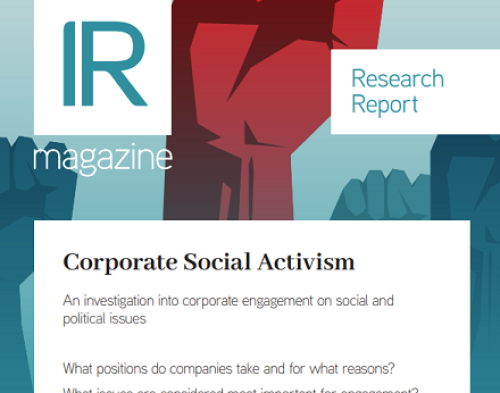In the dynamic landscape of financial decision-making, the importance of non-financial objectives – encapsulated in ESG criteria – has become central for governments, corporations and investors. Even as recent forecasts project a significant increase in ESG-related assets under management, concerns about the potential impact on returns persist. That has significant implications for IR professionals, who must guide their investors and reshape dialogues with various stakeholders.
A paradigm shift in capital allocation
The monumental growth in ESG-related assets underscores the paradigm shift in financial priorities. PwC forecasts that ESG-related assets under management will increase from $18.4 tn in 2021 to $33.9 tn by 2026, with ESG assets on pace to constitute 21.5 percent of total global assets under management. Bloomberg Intelligence expects global ESG assets to exceed $53 tn by 2025, representing more than a third of total assets under management.
Amid this growth, however, skepticism prevails. Some investors, echoing concerns from academic studies, have expressed a skeptical view of the effectiveness of ESG investing. There has also been strong pushback from investors, partly because ESG investing reduces investment returns. For example, several states in the US have introduced proposals against ESG investing, while 25 states have sued the Biden administration to halt a Department of Labor rule that prioritizes ESG concepts in retirement fund regulations.
Are these misgivings about ESG investing valid? Does ESG investing necessarily imply lower returns? Not necessarily. To understand why this is the case, one must consider the effect of ESG investing on the cost of capital.
Understanding the cost of capital
Popular implementations of responsible ESG-investment strategies are, for example, portfolio screens that limit investment in environmentally harmful ‘brown’ firms, or portfolio mandates that encourage investment in environmentally friendly ‘green’ firms. In this way, ESG-investing strategies redirect the supply of capital from harmful firms to responsible ones. The traditional argument asserts that this redirection could affect the cost of capital, creating a spread between the cost of capital for brown and green firms.
Of course, because the cost of capital to a company is the return earned by its shareholders, it is argued that increasing the supply of investment to green assets necessarily implies lowering the returns from these investments. Similarly, it is assumed that decreasing the supply of investment to brown assets will increase the returns from these assets. Thus, it is argued that ESG investing would lead to a spread in the returns from investing in brown and green firms.
A strategic edge for IR professionals
If a firm’s demand for capital is elastic – meaning it can scale without diminishing returns – the impact of ESG mandates on capital allocation can be significant without a commensurate effect on returns. In other words, contrary to assumptions that are made explicitly in existing academic work and implicitly in discussions among investment professionals when discussing the implications of ESG investing, my research demonstrates that when the demand for capital from firms is elastic, ESG mandates can drive substantial changes in physical capital allocation without markedly affecting the cost of capital.
Therefore, when the demand for capital from firms is elastic, judging the effectiveness of responsible portfolio mandates by their impact on the expected rate of return (cost of capital) of green and brown stocks can be misleading. This insight challenges the conventional wisdom that ESG investing necessarily leads to diminished returns, offering IR professionals a more optimistic narrative.
The empirical question of whether returns to scale are close to constant becomes pivotal. Empirical estimates from several macroeconomic studies suggest so. In fact, in the green sector, returns may grow more in line with capital input due to network externalities and ‘learning by doing’. In this case, shifting capital to the green sector could even lead to higher returns for investors in the green sector.
This insight provides a foundation for IR professionals to counter misgivings, illustrating that capital shifts to the green sector might be not only environmentally responsible but also financially rewarding.
Elevating the ESG conversation
Armed with the knowledge that ESG-motivated mandates can substantially impact capital allocation without affecting the cost of capital, IR professionals gain a strategic edge and addressing the concerns of ESG-resistant investors becomes more nuanced. Instead of focusing solely on the cost of capital, IR professionals can underscore the substantial differences in physical capital allocation across green and brown sectors.
My research aligns with the experiences of seasoned IR professionals, reinforcing the idea that a myopic focus on returns might miss the broader positive impact of ESG investments. By embracing a holistic view, IR professionals can communicate that ESG-conscious investments need not sacrifice returns; rather, they can advance ESG goals while maintaining robust financial performance.
In conclusion, the trajectory of ESG investing demands a strategic shift in how IR professionals engage with investors. My research offers a roadmap for navigating the ESG landscape, emphasizing that the impact of ESG mandates extends beyond the cost of capital. IR professionals can champion ESG investments by highlighting substantial shifts in physical capital allocation while reassuring investors that returns need not be compromised.
As stewards of the investor relationship, IR professionals have a unique opportunity to reshape narratives, debunk misgivings and lead the charge toward a sustainable and financially prosperous future.
Raman Uppal is professor of finance at EDHEC Business School










